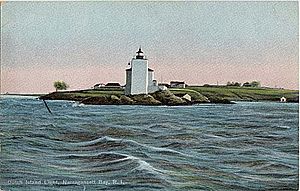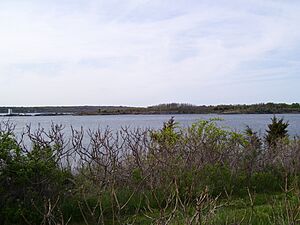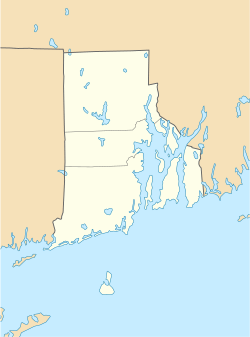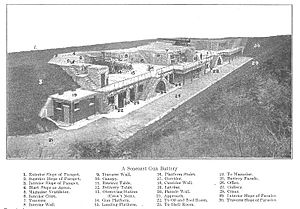Dutch Island (Rhode Island) facts for kids
Dutch Island is a small island located in Narragansett Bay in Rhode Island, United States. It sits west of Conanicut Island. This island is part of the town of Jamestown, Rhode Island. It covers about 102.7 acres (0.4156 square kilometers) of land. In the year 2000, no one lived on the island.
Dutch Island was an important military site for many years. It was fortified from the American Civil War all the way through World War II. During this time, from 1898 to 1947, it was known as Fort Greble.
Contents
History of Dutch Island
The Native American name for Dutch Island was Quotenis or Quetenesse. Around 1636, a man named Abraham Pietersen van Deusen from the Dutch West India Company set up a trading post here. He traded Dutch goods like cloth and tools with the Narragansett Indians. They exchanged these for furs, fish, and deer meat.
Later, in 1654, English colonists bought the island from the Native Americans. In 1825, the United States government bought 6 acres (24,000 square meters) at the island's south end. This was to build the Dutch Island Light. The lighthouse started working on January 1, 1827. It helped guide ships into Narragansett Bay. The first lighthouse tower was 30 feet (9 meters) tall and built from stones found on the island. In 1857, a new 42-foot (13 meters) brick tower was built. A fog bell was added in 1878 to help ships in foggy weather.
Today, you won't find any signs of the old Dutch trading post. However, the lighthouse and some military buildings from later times are still on the island.
Fort Greble
Quick facts for kids Fort Greble |
|
|---|---|
| Part of Harbor Defenses of Narragansett Bay | |
| Dutch Island, Rhode Island | |
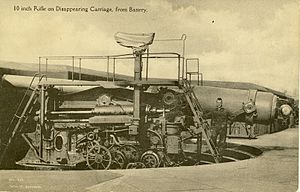
A 10-inch disappearing gun at Fort Greble.
|
|
|
Location in Rhode Island
|
|
| Coordinates | 41°30′14″N 71°24′00″W / 41.50389°N 71.40000°W |
| Type | Coastal Defense, later POW camp |
| Site information | |
| Owner | Rhode Island Dept of Environmental Management |
| Open to the public |
No |
| Condition | Fair |
| Site history | |
| Built | circa 1895 |
| Built by | United States Army Corps of Engineers |
| In use | 1897-1947 |
| Battles/wars | World War I, World War II |
Fort Greble was named after First Lieutenant John Trout Greble. He was an officer in the U.S. Army. He was the first officer from the Regular Army to be killed in the Civil War. In 1863, the land on Dutch Island was sold to the U.S. government. By 1864, the Army had taken control of the island.
Fort Greble During the Civil War
During the American Civil War, Dutch Island was used as a training area. The 14th Rhode Island Heavy Artillery (Colored) trained here. These soldiers built the first earth defenses on the island. Construction continued even after the Civil War ended.
An eight-gun battery was built and armed by the 14th Rhode Island soldiers in 1863-64. Another battery was planned for eleven large 10-inch Rodman guns. This battery was at the south end of the island. It was designed to fire in many directions. However, it often flooded and was never actually armed with guns.
Fort Greble and the Spanish-American War
After the Civil War, more gun batteries were added to Dutch Island. In 1870, there was a big plan for a huge fort. It would have had forty 15-inch Rodman guns. But funding for this project stopped in 1875. Most money for coastal defenses across the country was cut around this time.
However, new plans came from the Board of Fortifications in the late 1890s. This led to the building of Fort Greble. It became part of the Harbor Defenses of Narragansett Bay. The Spanish–American War sped up this construction. Tunnels and gun positions were built, and the fort grew until 1902.
The first part of Fort Greble was Battery Hale, finished in 1897. It had three 10-inch disappearing guns. These guns could hide behind a wall after firing. Soon after the war began, a battery for one 6-inch Armstrong gun was built. This gun was removed in 1903. Then, Battery Mitchell was built on the same spot. It had three 6-inch disappearing guns. Battery Sedgwick had eight large 12-inch mortars. Finally, Battery Ogden was finished in 1900. It had two 3-inch rapid-fire guns that could also retract.
The fort also had equipment to control an underwater minefield. These mines were stored at Fort Wetherill.
The batteries were named after important people:
- Battery Hale was named for Revolutionary War hero Nathan Hale.
- Battery Mitchell was named for Captain David D. Mitchell, who died in the Philippine–American War.
- Battery Sedgwick was named for Major-General John Sedgwick, who died in the Civil War.
- Battery Ogden was named for Frederick C. Ogden, an officer who died in the Civil War.
Training Exercises Between the World Wars
The New York Times reported a large training exercise on June 26, 1908. Soldiers from Fort Adams and Fort Greble took part. They practiced a pretend land and sea attack on the island. The loud sounds of the fort's guns kept people in Newport and Jamestown awake all night.
On April 2, 1912, an accident happened. Corporal William W. Lee put too much powder into Fort Greble's morning reveille gun. The gun usually used only a small amount of black powder. When he pulled the rope, the back of the gun exploded. Corporal Lee was badly hurt and later died. His grave is in Jamestown's town cemetery.
Fort Greble During the World Wars
During World War I, Fort Greble was home to nearly 500 soldiers. Colonel Charles Foster Tillinghast, Sr. was in command. Some of the fort's guns were taken apart in 1917-18. This was so they could possibly be used on the Western Front in France.
One 10-inch gun from Battery Hale was removed to be made into a railway gun. It was replaced by a similar gun from Fort Wetherill in late 1918. The three 6-inch guns from Battery Mitchell were removed in 1917. They were sent to France for use on wheeled carriages. However, they were never sent back to Fort Greble. None of the soldiers training with these 6-inch guns finished their training before the war ended.
Four of Battery Sedgwick's eight 12-inch mortars were also removed in 1918. This was to possibly use them as railway artillery. It also helped make reloading the remaining mortars faster.
Battery Ogden's 3-inch guns were taken out of service in 1920. This was part of a plan to remove all M1898 3-inch guns. The fort was active until the mid-1920s. It was then put into "caretaker status." This meant it was not fully active. The fort's water tanks were broken and could not hold enough water for the soldiers.
During World War II, Fort Greble was used as a German prisoner-of-war camp. The fort was officially closed in 1947. Its guns were scrapped in 1942. This happened because new and better defenses were built. These new defenses were centered around Fort Church and Fort Greene.
Dutch Island Since World War II
Since World War II, there have been no major efforts to rebuild or preserve Dutch Island. It has been used as a training area for the Rhode Island National Guard. The State of Rhode Island owns the island. It is now a wildlife management area. This means it is protected for animals and nature.
In 2016, the Army Corps of Engineers finished a project. They worked to make the island safer by removing hazards.
Images for kids


